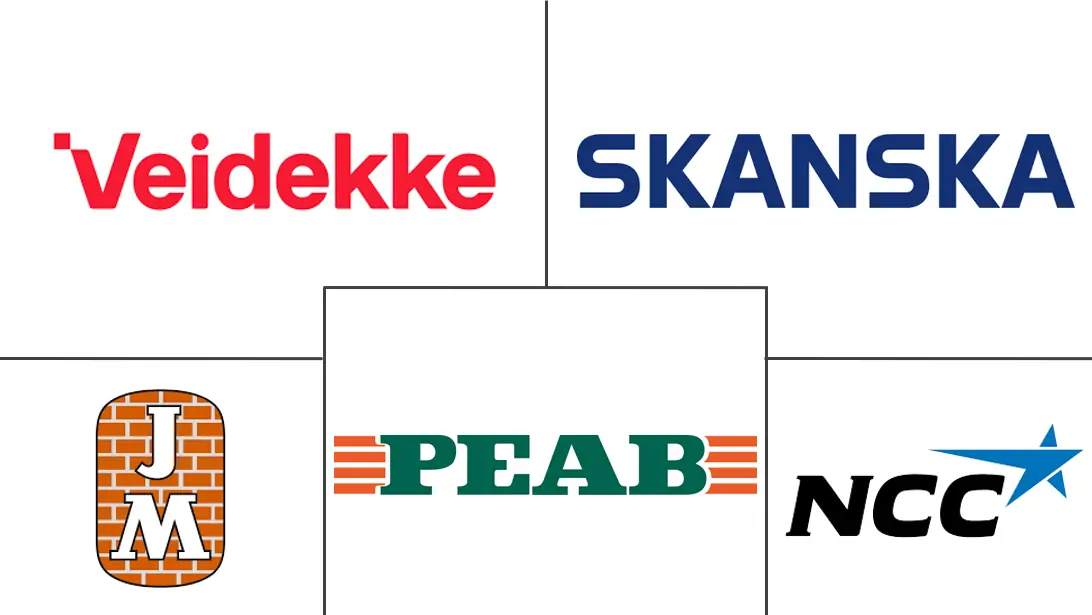Scandinavia Construction Market Size and Share
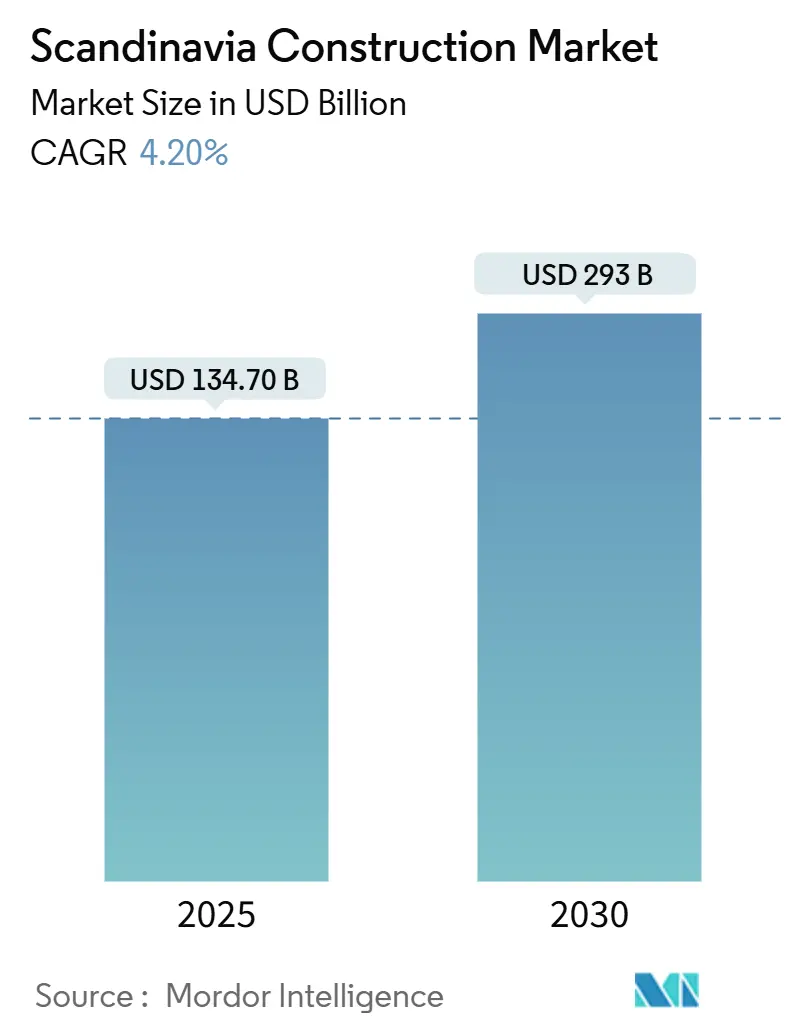
Scandinavia Construction Market Analysis by Mordor Intelligence
The Scandinavia Construction Market size is estimated at USD 134.70 billion in 2025, and is expected to reach USD 293 billion by 2030, at a CAGR of 4.20% during the forecast period (2025-2030). Activity rebounded after a steep 11% contraction in 2024 and a further 4% dip in early 2025 as monetary easing, infrastructure stimulus, and stabilising material costs restored confidence. Infrastructure outlays—especially rail corridors, tunnels and energy-related assets—are widening order books, while residential building begins to stabilise as mortgage rates retreat. Adoption of modern construction methods, stringent carbon rules, and rising private capital allocations are reshaping competitive strategies across the region. Contractors with strong prefabrication capabilities, robust labour pipelines, and digital project controls are winning the largest share of new tenders and achieving higher margins despite lingering cost pressures.
Key Report Takeaways
- By sector, infrastructure surpassed all peers with a 6.1% CAGR outlook to 2030, whereas the residential segment led the 2024 revenue tables with 48% of the Scandinavia construction market share.
- By geography, Sweden captured 44% of the Scandinavia construction market share in 2024, while Denmark is projected to expand at a 5.8% CAGR through 2030.
- By construction type, new-build activity accounted for an 83% share of the Scandinavia construction market size in 2024, whereas renovation is projected to advance at a 5.4% CAGR between 2025-2030.
- By construction method, conventional on-site techniques held 63% of the Scandinavia construction market share in 2024; modular and other MMC formats are forecast to grow at a 6.9% CAGR through 2030.
- By investment source, public funding contributed a 52% share of the Scandinavia construction market size in 2024, though private capital is projected to rise at a 5.1% CAGR between 2025-2030.
Scandinavia Construction Market Trends and Insights
Drivers Impact Analysis
| Drivers | (~) % Impact on CAGR Forecast | Geographic Relevance | Impact Timeline |
|---|---|---|---|
| Mass timber and CLT uptake | +1.2% | Sweden, Finland, Norway | Medium term (2-4 years) |
| Urban rail and transit expansions | +1.5% | Sweden, Denmark, Norway | Long term (≥ 4 years) |
| Urban housing shortage | +0.8% | Sweden, Denmark | Medium term (2-4 years) |
| Reshored manufacturing & clean-energy sites | +1.0% | Norway, Sweden | Long term (≥ 4 years) |
| Cross-border PPP rail projects | +0.7% | Sweden, Denmark, Norway | Long term (≥ 4 years) |
| Source: Mordor Intelligence | |||
Growing Adoption of Mass Timber and Cross-Laminated Timber (CLT) in Sustainable Construction
Nordic climate targets are accelerating the shift from concrete and steel to engineered wood. Denmark imposed whole-building carbon limits in 2023, and Sweden and Finland will follow in 2025, giving timber a regulatory head start. Finland’s Katajanokan Laituri—7,600 m³ of prefabricated timber—became the nation’s largest wood building in 2024, while Malmö’s 12-storey ETC Hyllie project signals high-rise mainstreaming. Developers report faster sales and rental premiums on timber assets thanks to aesthetic appeal and lower embodied carbon. Factories supplying CLT panels now operate at near capacity, widening the addressable pool for prefabricated and hybrid solutions across the Scandinavia construction market.
Urban Rail and Transit Infrastructure Expansions to Support Growing City Populations
Governments are prioritising rail corridors that double as economic arteries. Sweden selected contractors for the North Bothnia Line and advanced Stockholm’s first driverless metro, underscoring a pivot toward automated, high-frequency transit. Norway allocated USD 40.13 billion for rail through 2036, demonstrating sustained funding even amid fiscal prudence.[5]Urban Transport News, “Norway Rail Infrastructure Plan" Projects integrate housing, manufacturing and logistics sites, aligning transport planning with long-term competitiveness. As a result, rail packages now represent a growing slice of the Scandinavia construction market pipeline and attract specialised PPP financiers.
Widening Urban Housing Shortage Driving Multi-Family and High-Density Development
Stockholm and Copenhagen face tight housing supply, prompting city planners to fast-track multi-family approvals. Housing prices outpaced completions through 2024, pushing policymakers toward inclusionary zoning and community-amenity mandates. Developers that pair density with shared mobility hubs, green roofs and energy-positive systems secure building permits more quickly and command higher occupancy. Such integrated projects are enlarging the addressable base of the Scandinavia construction market beyond traditional greenfield subdivisions.
Reshoring of Manufacturing and Construction of Clean-Energy Facilities
Regulatory certainty and abundant renewables are drawing energy-intensive manufacturers northward. Sweden replaced its “100% renewable” vision with a “100% fossil-free” target, unlocking avenues for new nuclear reactors by 2035. Norway’s Northern Lights carbon-capture site began operations in 2024 and plans to triple capacity.[2]TotalEnergies, “Northern Lights Carbon Capture Project"These flagship projects require extensive civil works, port upgrades and workforce housing, feeding a new industrial-infrastructure wave that will anchor long-term growth in the Scandinavia construction market.
Restraints Impact Analysis
| Restraint | (~) % Impact on CAGR Forecast | Geographic Relevance | Impact Timeline |
|---|---|---|---|
| Tight monetary policy & mortgage affordability | -1.3% | Sweden, Norway, Denmark | Short term (≤ 2 years) |
| Ageing labour pool & skills mismatch | -0.9% | Sweden, Norway, Denmark | Long term (≥ 4 years) |
| Supply-chain instability & material inflation | -0.8% | Sweden, Norway, Denmark | Medium term (2-4 years) |
| Source: Mordor Intelligence | |||
Tight Monetary Policy and High Interest Rates Reducing Mortgage Affordability
Elevated policy rates slashed Norwegian housing starts by 33% and new-home sales by 45% in 2023. Swedish housing investment dropped 55% that year, the steepest fall since the early 1990s. Central banks now signal cuts to 2% by late 2025. Developers pivoted to energy-efficient, modular units offering lower operating costs and flexible financing to maintain sales velocity. Prefabrication and value engineering are emerging as buffers that protect margins across the Scandinavia construction market until borrowing costs normalise.
Labour Availability Constraints Due to Ageing Workforce and Skills Mismatch
Roughly 10% of Sweden’s construction workforce will retire by 2028 . Denmark’s sector recorded a 32% failed recruitment rate, underscoring systemic shortages . Firms counter this drag with automation, expanded apprenticeship pipelines and strategic immigration channels. Integrating BIM, robotics and prefabrication reduces onsite labour intensity, allowing contractors to secure schedules even as skill gaps widen in the Scandinavia construction market.
Segment Analysis
By Sector: Infrastructure Drives Future Growth
Infrastructure overtook other segments as the principal growth engine, set for a 6.1% CAGR through 2030. Sweden’s green-lit North Bothnia Line and Norway’s USD 42.56 billion rail plan headline robust public pipelines. Residential activity still contributed the largest 48% revenue slice in 2024, but rising mortgage eligibility thresholds curbed starts until rate cuts filter through. Commercial projects in logistics and light industry benefited from reshoring and e-commerce tailwinds, cushioning the Scandinavia construction market during the recent downturn.
Public spending now targets resilience and climate targets rather than pure capacity. Rail corridors integrate renewable generation, carbon-capture hubs and broadband conduits. Contractors with design-build-operate credentials secure recurring revenue streams across asset lifecycles. Meanwhile, traditional homebuilders are branching into civil packages or partnering with infrastructure specialists to offset residential cyclicality.
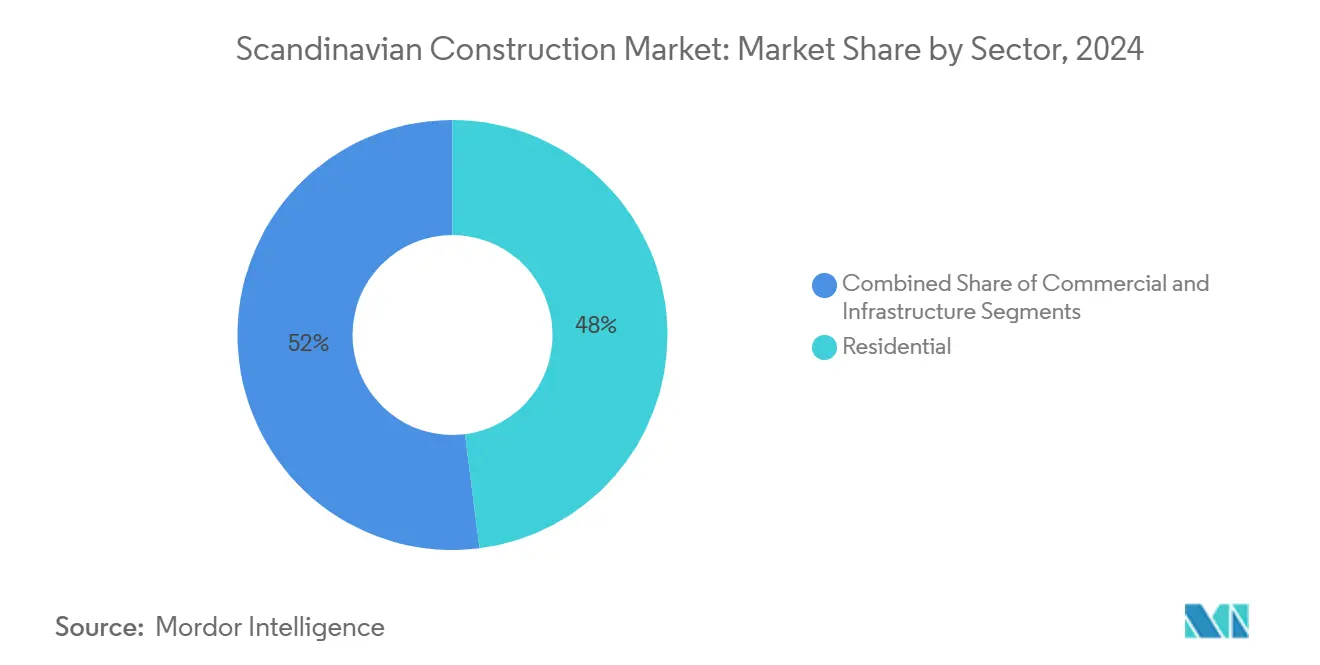
Note: Segment shares of all individual segments available upon report purchase
By Construction Type: Renovation Gains Momentum
New projects accounted for 83% of 2024 turnover, but renovation will expand at 5.4% annually as owners pursue carbon-footprint reductions. Denmark’s 7.1 kg CO2e/m²/year limit set for July 2025 is steering investments toward deep-retrofit programmes . Environmental Product Declarations became standard procurement criteria, driving demand for expertise in life-cycle analysis.
Projects now bundle insulation upgrades, smart-grid readiness and indoor-air improvements, elevating renovation from maintenance to strategic asset-value creation. Firms fluent in holistic building diagnostics, tenant engagement and performance guarantees command price premiums and protect backlog diversity within the Scandinavia construction market.[4]Nordic Council of Ministers, “Carbon Limit Values for Nordic Buildings"
By Construction Method: Modern Methods Disrupt Traditional Practices
Conventional onsite activity still captured 63% of 2024 spend, yet MMC approaches are accelerating at 6.9% CAGR. The prefabricated housing segment is projected to grow from USD 33.16 billion in 2024 to USD 50.04 billion by 2034. Skanska, NCC and Lindbäcks scaled design-for-manufacture workflows that cut waste and compress schedules. In Sweden the turnkey solutions niche is on track to exceed half of prefabricated deliveries, advancing roughly 7% per year.
Manufacturers now function as solution integrators, bundling design, logistics and onsite assembly. This vertical shift recasts competition and allows MMC pioneers to secure large-scale affordable-housing contracts. Sustainability benefits—lower waste and tighter tolerances—further align MMC adoption with Nordic climate regulations, embedding it within long-range procurement policies across the Scandinavia construction market.
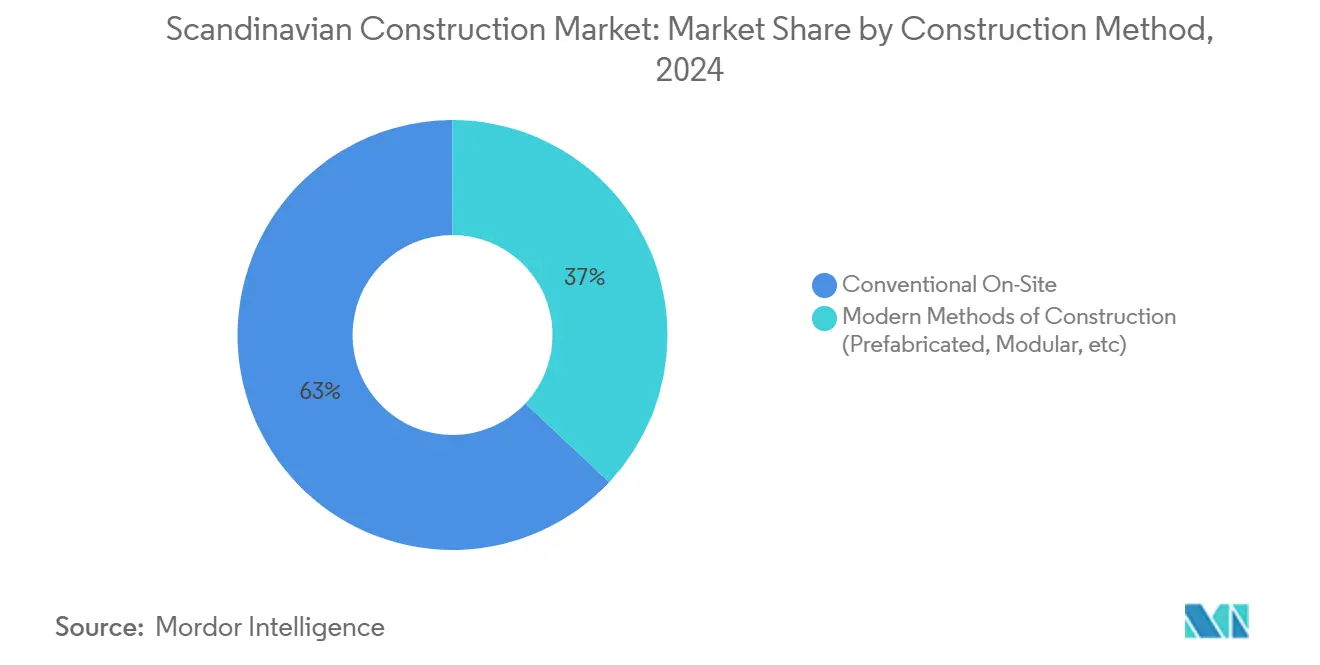
Note: Segment shares of all individual segments available upon report purchase
By Investment Source: Private Capital Accelerates Growth
Public funds supplied 52% of 2024 spending; however private inflows are forecast at 5.1% CAGR. Pension funds and sovereign wealth vehicles are enlarging infrastructure allocations to meet ESG mandates. Norges Bank Investment Management acquired a 49% stake in Thor and Nordseecluster offshore-wind builds for USD 1.58 billion, with total commitments of USD 4.5 billion.[6]European Investment Bank, “Cross-Border Infrastructure Projects"
Authorities reciprocate by structuring balanced PPP contracts that limit downside while unleashing innovation. This symbiotic capital mix broadens project tally and mitigates fiscal ceilings, ensuring that long-term strategic corridors move ahead even as public budgets tighten. Consequently private investors now influence specification standards, digital-twin requirements and life-cycle performance clauses throughout the Scandinavia construction market.
Geography Analysis
Sweden retained 44% of regional spending in 2024, underpinned by defence, justice and green-industry assets even as housing faltered. GDP is forecast to advance beyond 2.5% in 2025, and non-residential pipelines remain buoyant thanks to nuclear-power expansion plans that include two reactors by 2035.[3]World Nuclear Association, “Nuclear Power in Sweden" Residential starts should revive as the central bank eases rates, tempering the earlier 55% investment slide and supporting the wider Scandinavia construction market size for Sweden.[1]Swedish Transport Administration, “North Bothnia Line Project Details"
Denmark is poised for the fastest growth at 5.8% CAGR, aided by upbeat industrial production and gas extraction. The forthcoming 7.1 kg CO2e cap per square metre is spurring low-carbon materials and retrofit demand. Offshore-wind megaprojects attract multinational capital, reinforcing Denmark’s positioning as a sustainability demonstrator and expanding opportunities for specialised contractors.
Norway experienced a 6% drop in overall construction output in 2023, yet infrastructure and energy projects remain robust. The landmark Rogfast subsea tunnel, half completed by 2025, and the operational Northern Lights CCS scheme illustrate commitment to engineering feats that enhance transport resilience and decarbonisation. The Climate Act’s 55% emission-cut target by 2030 compels consistent public investment, balancing near-term housing softness and underpinning the Norway slice of the Scandinavia construction market.
Competitive Landscape
Market concentration is moderate: The Scandinavian construction market is moderately concentrated, with major players such as Veidekke ASA, Skanska AB, NCC AB, and Peab AB holding a significant share of the market. These firms benefit from strong order books and consistent demand across infrastructure and building sectors. At the same time, mid-sized and niche players continue to find growth opportunities by leveraging regional expertise, specialized services, and agile operations.
Digitalisation, BIM proficiency and industrialised building models are overriding traditional scale advantages. Contractors pairing strong technology stacks with workforce upskilling secure higher bid-prequalification scores and win framework agreements for multi-year rail and housing programmes. Sustainability consultancies and carbon-footprint auditors now partner with builders to meet stringent Nordic emission benchmarks, forging a layered ecosystem that lifts overall innovation across the Scandinavia construction market.
Scandinavia Construction Industry Leaders
-
Veidekke ASA
-
Skanska AB (Sweden)
-
NCC AB
-
Peab AB
-
JM AB
- *Disclaimer: Major Players sorted in no particular order
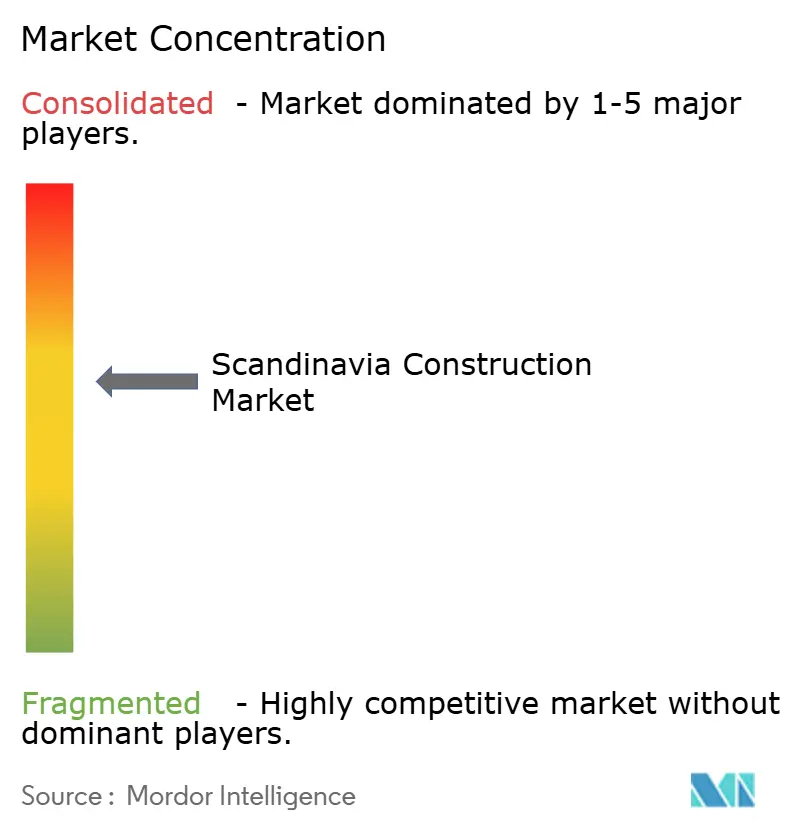
Recent Industry Developments
- April 2025: Sweden earmarked USD 97 million to accelerate fossil-free electricity output, including funds for nuclear-pilot schemes.
- April 2025: Norway advanced construction of the 26.7 km Rogfast tunnel, budgeted at USD 2.5 billion, with completion due in 2033.
- March 2025: Veidekke signalled that the Scandinavia construction market will resume growth in 2026 after a 4% decline in 2025.
- February 2025: Sweden approved the Dåva–Skellefteå section of the North Bothnia Line, with works slated to start between 2025 and 2027.
Research Methodology Framework and Report Scope
Market Definitions and Key Coverage
Our study defines the Scandinavian construction market as all on-site and off-site works that create, extend, or refurbish buildings and civil infrastructure across Denmark, Sweden, and Norway, valued at the invoice price of labor, materials, and fixed equipment. New build, major renovations, and large maintenance projects are in scope.
Scope exclusion: very small DIY repairs and purely temporary structures fall outside this definition.
Segmentation Overview
- By Sector
- Residential
- Apartments/Condominiums
- Villas/Landed Houses
- Commercial
- Office
- Retail
- Industrial and Logistics
- Others
- Infrastructure
- Transportation Infrastructure (Roadways, Railways, Airways, others)
- Energy & Utilities
- Others
- Residential
- By Construction Type
- New Construction
- Renovation
- By Construction Method
- Conventional On-Site
- Modern Methods of Construction (Prefabricated, Modular, etc)
- By Investment Source
- Public
- Private
- By Country
- Denmark
- Sweden
- Norway
Detailed Research Methodology and Data Validation
Primary Research
To close data gaps, we interview contractors, materials suppliers, site engineers, project financiers, and municipal procurement officers across all three countries. These conversations clarify cost-per-square-meter shifts, typical lead times, average utilization rates, and near-term bid pipelines, which help us verify headline volumes and refine country-level price assumptions.
Desk Research
Analysts start with public data that anchor activity levels, such as annual production indices from Statistics Denmark, Statistics Norway, and Statistics Sweden, building-permit dashboards from Nordic national planning agencies, and Eurostat gross fixed capital formation tables. Trade-body bulletins from the Swedish Construction Federation and the Danish Construction Association add project pipelines, while energy-efficiency retrofit volumes come from the International Energy Agency. Company filings retrieved through D&B Hoovers and news flows from Dow Jones Factiva complement macro inputs and reveal tender backlogs and order books. These sources illustrate employment swings, materials inflation, and contract awards that feed our base calculations. The examples listed are illustrative; many other sources were reviewed to complete data collection and sense-check trends.
Market-Sizing & Forecasting
We build the 2024 baseline through a top-down roll-up of national construction output accounts, reconstructed into our scope and currency. Results are cross-checked with selective bottom-up tests, such as sampled average selling price multiplied by residential completions and supplier revenue roll-ups. Key variables modeled each year include building-permit area, civil-works tender value, material cost indices, labor productivity, housing-starts to population ratio, and public capital-spending plans. Forecasts to 2030 apply a multivariate regression that links those drivers to historical output, with scenario adjustments validated by our interview panel. Where bottom-up samples diverge, we adjust using weighted averages that favor the most reliable series.
Data Validation & Update Cycle
Outputs pass two rounds of peer review, followed by an anomaly screen that flags swings above one standard deviation versus historic norms. We reconnect with sources when large tenders, policy shifts, or price spikes occur. Mordor updates this model every twelve months and issues interim refreshes for material events, so clients always receive our latest view.
Why Mordor's Scandinavia Construction Baseline Commands Reliability
Published values often differ because providers choose unique sector mixes, price bases, and refresh cadences. Recognizing this, Mordor analysts disclose their scope choices and update rules, giving users a transparent starting point.
Key gaps arise when other publishers bundle minor household repairs, apply single-country deflators to tri-nation totals, or lock growth paths to unvalidated optimism. Our base year is built from official output accounts, our cost stack is country-specific, and our model is re-benchmarked annually, which limits drift.
Benchmark comparison
| Market Size | Anonymized source | Primary gap driver |
|---|---|---|
| USD 234.9 B | Mordor Intelligence | - |
| USD 130.5 B | Regional Consultancy A | Narrows scope to residential new-build only and uses constant 2020 prices |
| USD 135.0 B | Trade Journal B | Applies fixed exchange rate and omits renovation spending |
These comparisons show that when scope discipline, localized price tracking, and timely updates align, the resulting baseline, Mordor's, remains the dependable yardstick for strategic decisions.
Key Questions Answered in the Report
What is the current value of the Scandinavia construction market?
Spending reached USD 134.7 billion in 2025 and is projected to climb to USD 293.0 billion by 2030 at a 4.2% CAGR.
Which segment shows the fastest growth potential?
Infrastructure leads with a 6.1% CAGR outlook, driven by large rail, tunnel and clean-energy projects across Sweden, Norway and Denmark.
How significant is modular and prefabricated building in Scandinavia?
Modern Methods of Construction represent 37% of activity and are expanding at 6.9% a year, fuelled by labour shortages and carbon regulations.
Why is Denmark forecast to outpace Sweden and Norway?
Progressive carbon caps, strong industrial output and major offshore-wind investments push Denmark toward a 5.8% CAGR through 2030.
What financing trends shape future project pipelines?
Private capital, particularly pension and sovereign funds, is growing faster than public spending, underpinned by balanced PPP frameworks and ESG commitments.
How are contractors tackling labour shortages
Firms integrate BIM, robotics and expanded apprenticeship programmes while accelerating prefabricated production to reduce onsite labour intensity.
Page last updated on:
